Speleology belongs to the Earth sciences. It mostly concerns itself with natural hollow spaces, concentrating on the exploration and surveying of caves, the courses of subterranean waterways, and the description of cave contents. Just like observing the endless vastness of the universe, looking at the hidden world underground brings new understanding of the past and contributes to our thinking about the future. Our everyday life benefits from the information gained from observing the underground watercourses.
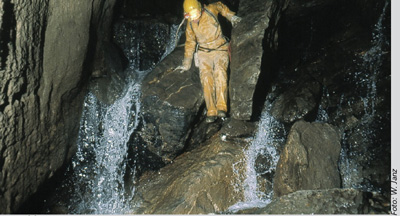
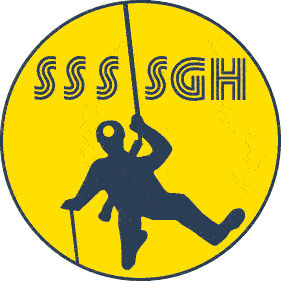

Caves are no older than the rocks surrounding them. They are created by the changing conditions of the environment. Protected from short-term events, they are a valuable archive of past times. Events from geological cycles are depicted in the shape of passages and sediment.
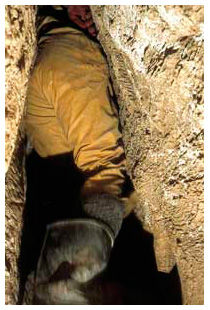 To move around in caves safely, excellent equipment is required. In this realm of perpetual darkness, powerful reliable lamps are of immense importance. Many obstacles have to be overcome – steep and perpendicular sections of passages with single rope technique, water-filled stretches with diving equipment, narrow passages with patient use of one's own flexibility.
To move around in caves safely, excellent equipment is required. In this realm of perpetual darkness, powerful reliable lamps are of immense importance. Many obstacles have to be overcome – steep and perpendicular sections of passages with single rope technique, water-filled stretches with diving equipment, narrow passages with patient use of one's own flexibility.
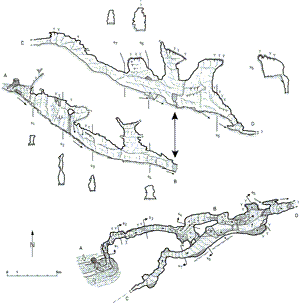 |
||
The drawing of cave maps depends on teamwork and requires a survey of the cave. This survey is generally carried out as a polygon course – the cave is measured between points. The measuring instruments are usually compass, measuring tape and inclinometer. Digital and laser equipment are also used. A great deal of practice is necessary to avoid measuring errors. |
||
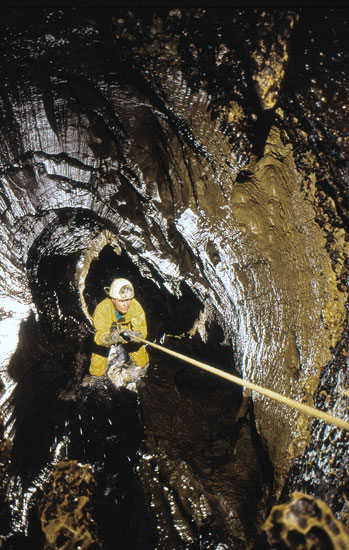
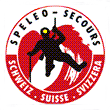
Cave rescue
In cave exploration accidents are fortunately rare.
Any rescue is, however, very difficult. That is why the Swiss Speleoloical Society (SSS) founded a rescue organisation.
The Speleo-Secours Schweiz is a country-wide rescue organisation with 220 rescuers. It performs search and rescue operations in caves and in other places difficult to reach, for which the participation of specially trained rescuers who are familiar with such situations is a necessity. Speleo Secours Schweiz works in close cooperation with REGA (Swiss air rescue organisation). An accident that happens underground usually makes retrieval of the casualty very difficult. The number of obstacles and the cave environment are the main reasons.
It is impossible to remove a casualty by any other path than the one that brought him there in the first place. This is the big difference between cave rescue and mountain rescue, which benefits largely from rescue by air.
Speleology is a passion
Curiosity, the impetus of all research, is a powerful driving force. To enter into the unknown, to experience a new world, is fascinating. The most interesting challenge is to make this world visible with the help of surveys, maps and also other detailed descriptions, so as to better understand the context. The cave leaves a strong impression on the speleologists, also during stays without scientific activity. They are comparable to those experienced by tourists visiting a cathedral or admiring jewels in a museum in a foreign town.
Why go caving?
Exploring the unknown and hidden things we encounter, lies within human nature. For example, if a hole is cut out in a construction site wall, many people are interested in what is hidden behind it. With caves, the unknown is tempting us to investigate, to enter. While, darkness and passage constrictiveness tend to scare us off, they are balanced on the other side by our curiosity to enter the hidden world of the underground through a cave entrance.
If curiosity prevails and we begin to record the discoveries, we become cave explorers.
How to find a cave
In Switzerland, more than 20% of the area is karst. Where there is limestone, there are probably caves. If caves are already known, there may be more in their vicinity. Information from the local population is usually very useful. Foresters, hunters, farmers and people who work in the countryside often provide very good information about interesting caves.
Often mysterious stories are told among friends gathered at the bar and restaurant table. Stories include tales of underground little people, reports of an underground lake, and reports that a child fell into a hole a long time ago and came out on the other side of the mountain a day later. Fortunately, such stories are written down in numerous books and newspapers, legends and folktales. Such clues can also lead to the discovery of a cave, e.g. reports of springs with strongly fluctuating fills are sure signs of a possible, passable cave system.
Finally, there is the systematic prospection, after which fixed areas are scanned and searched to the square metre.